Publications
Manuscripts In Preparation
Christopher Wyenberg, Alexandre Cooper
Abstract
We introduce a method for computing the dissipative dynamics resulting from the coupling of spin and kinematic degrees of freedom in chains of neutral atoms with Rydberg interactions. We derive an effective quantum channel to efficiently evaluate the coefficients of the reduced spin density matrix obtained in the presence of spin-motion coupling, and benchmark the accuracy of our method against exact diagonalization results on two atoms. We then compute the fidelity loss in the transport of spin excitations across longer chain lengths and explore spin-motion entanglement regimes intractable via exact diagonalization methods. We identify an optimal trap depth for maximizing the quantum-classical crossover length in an entanglement transport protocol executed on a near-term Rubidium-87 quantum simulator. Our method significantly reduces the complexity of simulating spin dynamics coupled to kinematic degrees of freedom and can be readily employed to estimate the detrimental effects of spin-motion coupling in quantum many-body dynamics and optimal control scenarios. Our method provides the reduction in complexity necessary to model dynamics of near-term experiments for which numerical evaluation of spin-motion corrections is otherwise inaccessible.
Kent Ueno, Christopher Wyenberg, Alexandre Cooper-Roy
Abstract
We study the transport of spin excitations in chains of neutral atoms with dressed Rydberg interactions. A perfect transport condition [define] is realized by tuning the relative distance between the atoms and applying atom-selective detuning fields. We identify the set (of physical and control) parameters that maximizes the probability of coherently transporting a single spin excitation from one end of the chain to the other. Our results highlight a tradeoff between transport time and breakdown of second-order perturbation theory. We then show that the probability of perfect transport increases with the principal quantum number of the Rydberg state. This increase results from the beneficial increase in the radiative lifetime and interaction coefficients, despite a decrease in effective Rabi frequency. We finally quantify the reduction in the probability of perfect transport caused by radiative decay, interactions between non-neighboring atoms, spatial disorder, temporal fluctuations in control fields, and motional effects. Our results offer a first step towards simulating transport phenomena in condensed matter systems, benchmarking the realization of effective spin models, and engineering the transport information, distribute entanglement, and perform quantum gates between distant nodes in solid-state spin networks.
Adam Poertner, Christopher Wyenberg, Alexandre Cooper, Jim Martin
Abstract
We introduce a method to induce a linear Stark shift in neutral atoms excited to low orbital angular momentum Rydberg states. Our method relies upon perturbative coupling to other Rydberg states using continuous multichromatic microwave driving, where the constituent dressing frequencies are integer multiples of a common base frequency. We show that the linear shift can be understood and quantified via loop diagrams in one-to-one correspondence with perturbative terms in the multichromatic Floquet formalism, and we describe a minimal model for the induced shift along with its scaling properties. We prescribe constraints upon multichromatic dressing frequencies, phases, and relevant atomic level structure; additionally, we provide guidelines for inducing a strong linear shift with a wide dynamic dc field range. We compute the effect exactly for different Rydberg states under bichromatic driving fields, comparing to predictions of the minimal perturbative model and to other physical dipole quantities. We outline an experimental protocol for vector electrometry for both bulk atomic gases imaged using selective field ionization and configurations of individual atoms imaged using atom-resolved fluorescence. Our results open up opportunities for Rydberg electrometry without bias fields as well as increased tunability for quantum information processing with Rydberg atom arrays.
Amir Hossein Dadpour, Timur Khayrullin, Fouad, Izzat, Amer, Alexandre Cooper-Roy
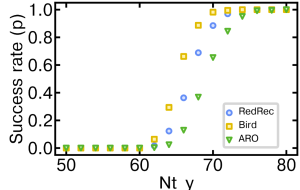
Abstract
Programmable quantum simulators offer a near-term opportunity to explore many-body physics in regimes inaccessible through classical computation, with implications for solving practically relevant problems. Realizing this opportunity requires leveraging real-time feedback control systems (RTFCs) to prepare, manipulate, and read out the state of quantum simulators, ideally in a closed-loop fashion. However, these RTFCs usually suffer from high latency, especially when involving the acquisition and processing of large amounts of data, as well as computing the feedback signals on a timescale faster than relevant error rates. Here, we report on the development of a low-latency RTFCs suitable for improving the performance of programmable quantum simulators based on configurations of atomic particles, such as Rydberg atom arrays. The system is based on a modular and cost-effective computer architecture built around a motherboard and peripheral cards, supplemented with easy-to-deploy software and efficient pre-optimized algorithms. We first quantify its performance at generating large arrays of optical traps with homogeneous intensity profiles using active diffractive optical elements such as acousto-optic deflectors and spatial light modulators. We then quantify its performance at preparing large configurations of neutral atoms without defects in linear chains and grids of optical traps, using both operational and runtime performance as our metric. This low-latency reconfiguration system relies on efficient implementation of atom reconfiguration algorithms and seamless integration of imaging systems, processors, and actuation devices. Upon optimizing all steps of the closed-loop reconfiguration cycle, we show that the runtime performance is ultimately limited by hardware performance. These results demonstrate that the proposed RTFC architecture can achieve low-latency execution of quantum state manipulation for a broad range of applications; the system can readily be used for preparing large arrays of optical traps and large configurations of atomic particles, as well as stabilizing control parameters, implementing adaptive control protocols and quantum error codes.
Soroush Khoubyarian, Artem Zhutov, Anastasiia Mashko, Alexandre Cooper
Abstract
Coming Soon!
Efficient algorithms to solve atom reconfiguration problems
Barry Cimring, Remy El Sabeh, Marc Bacvanski, Stephanie Maaz, Izzat El Hajj, Naomi Nishimura, Amer E. Mouawad, and Alexandre Cooper
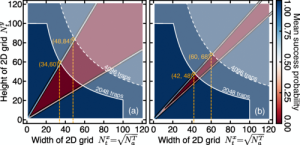
Abstract
We propose the redistribution-reconfiguration (red-rec) algorithm to prepare large configurations of atoms using programmable arrays of optical traps. Red-rec exploits simple heuristics and exact subroutines to solve atom reconfiguration problems on grids. It admits a fast and efficient implementation suitable for real-time operation. We numerically quantify its performance using realistic physical parameters and operational constraints, in both the absence and presence of loss. Red-rec enables assembling large configurations of atoms with high mean success probability. Fast preparation times are achieved by harnessing parallel control operations that actuate multiple traps simultaneously. Faster preparation times are achieved by rejecting configurations of atoms containing fewer atoms than a given threshold. However, the number of traps required to prepare a compact-centered configuration of atoms on a grid with a probability of 0.5 scales as the 3/2 power of the number of desired atoms. This finding highlights some of the challenges associated with scaling up configurations of atoms beyond tens of thousands of atoms.
Remy El Sabeh, Jessica Bohm, Zhiqian Ding, Stephanie Maaz, Naomi Nishimura, Izzat El Hajj, Amer E. Mouawad, and Alexandre Cooper
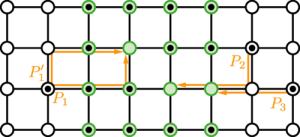
Abstract
Programmable arrays of optical traps enable the assembly of configurations of single atoms to perform controlled experiments on quantum many-body systems. Finding the sequence of control operations to transform an arbitrary configuration of atoms into a predetermined one requires solving an atom reconfiguration problem quickly and efficiently. A typical approach to solving atom reconfiguration problems is to use an assignment algorithm to determine which atoms to move to which traps. This approach results in control protocols that exactly minimize the number of displacement operations; however, this approach does not optimize for the number of displaced atoms or the number of times each atom is displaced, resulting in unnecessary control operations that increase the execution time and failure rate of the control protocol. In this work we propose the assignment-rerouting-ordering (ARO) algorithm to improve the performance of assignment-based algorithms in solving atom reconfiguration problems. The ARO algorithm uses an assignment subroutine to minimize the total distance traveled by all atoms, a rerouting subroutine to reduce the number of displaced atoms, and an ordering subroutine to guarantee that each atom is displaced at most once. The ordering subroutine relies on the existence of a partial ordering of moves that can be obtained using a polynomial-time algorithm that we introduce within the formal framework of graph theory. We numerically quantify the performance of the ARO algorithm in the presence and in the absence of loss and show that it outperforms the exact, approximation, and heuristic algorithms that we use as benchmarks. Our results are useful for assembling large configurations of atoms with high success probability and fast preparation time, as well as for designing and benchmarking novel atom reconfiguration algorithms.
Phys. Rev. A 108 023108 (2023)
arXiv:2212.05586 (2022)
Alexandre Cooper-Roy, Stephanie Maaz, Amer E. Mouawad, Naomi Nishimura

Abstract
Our work is motivated by the challenges presented in preparing arrays of atoms for use in quantum simulation [10]. The recently-developed process of loading atoms into traps results in approximately half of the traps being filled. To consolidate the atoms so that they form a dense and regular arrangement, such as all locations in a grid, atoms are rearranged using moving optical tweezers. Time is of the essence, as the longer that the process takes and the more that atoms are moved, the higher the chance that atoms will be lost in the process. Viewed as a problem on graphs, we wish to solve the problem of reconfiguring one arrangement of tokens (representing atoms) to another using as few moves as possible. Because the problem is NP-complete on general graphs as well as on grids [4], we focus on the parameterized complexity for various parameters, considering both undirected and directed graphs, and tokens with and without labels. For unlabelled tokens, the problem is fixed-parameter tractable when parameterized by the number of tokens, the number of moves, or the number of moves plus the number of vertices without tokens in either the source or target configuration, but intractable when parameterized by the difference between the number of moves and the number of differences in the placement of tokens in the source and target configurations. When labels are added to tokens, however, most of the tractability results are replaced by hardness results.
Lecture Notes in Computer Science(), vol 13174. Springer, Cham.
Quantum control and metrology with alkaline-earth atoms
Ivaylo S. Madjarov, Jacob P. Covey, Adam L. Shaw, Joonhee Choi, Anant Kale, Alexandre Cooper, Hannes Pichler, Vladimir Schkolnik, Jason R. Williams & Manuel Endres
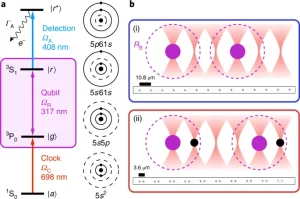
Abstract
Trapped neutral atoms have become a prominent platform for quantum science, where entanglement fidelity records have been set using highly excited Rydberg states. However, controlled two-qubit entanglement generation has so far been limited to alkali species, leaving the exploitation of more complex electronic structures as an open frontier that could lead to improved fidelities and fundamentally different applications such as quantum-enhanced optical clocks. Here, we demonstrate a novel approach utilizing the two-valence electron structure of individual alkaline-earth Rydberg atoms. We find fidelities for Rydberg state detection, single-atom Rabi operations and two-atom entanglement that surpass previously published values. Our results pave the way for novel applications, including programmable quantum metrology and hybrid atom–ion systems, and set the stage for alkaline-earth based quantum computing architectures.
Alexandre Cooper, Jacob P. Covey, Ivaylo S. Madjarov, Sergey G. Porsev, Marianna S. Safronova, and Manuel Endres
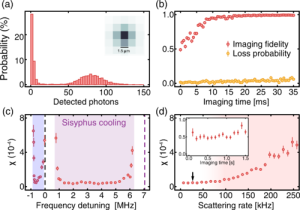
Abstract
We demonstrate single-shot imaging and narrow-line cooling of individual alkaline-earth atoms in optical tweezers; specifically, strontium trapped in 515.2−nm light. Our approach enables high-fidelity detection of single atoms by imaging photons from the broad singlet transition while cooling on the narrow intercombination line, and we extend this technique to highly uniform two-dimensional tweezer arrays with 121 sites. Cooling during imaging is based on a previously unobserved narrow-line Sisyphus mechanism, which we predict to be applicable in a wide variety of experimental situations. Further, we demonstrate optically resolved sideband cooling of a single atom to near the motional ground state of a tweezer, which is tuned to a magic-trapping configuration achieved by elliptical polarization. Finally, we present calculations, in agreement with our experimental results, that predict a linear-polarization and polarization-independent magic crossing at 520(2) nm and 500.65(50) nm, respectively. Our results pave the way for a wide range of novel experimental avenues based on individually controlled alkaline-earth atoms in tweezers—from fundamental experiments in atomic physics to quantum computing, simulation, and metrology.
Jacob P. Covey, Ivaylo S. Madjarov, Alexandre Cooper, and Manuel Endres
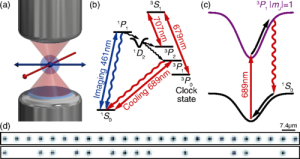
Abstract
We demonstrate single-atom resolved imaging with a survival probability of 0.99932(8) and a fidelity of 0.99991(1), enabling us to perform repeated high-fidelity imaging of single atoms in tweezers thousands of times. We further observe lifetimes under laser cooling of more than seven minutes, an order of magnitude longer than in previous tweezer studies. Experiments are performed with strontium atoms in 813.4 nm tweezer arrays, which is at a magic wavelength for the clock transition. Tuning to this wavelength is enabled by off-magic Sisyphus cooling on the intercombination line, which lets us choose the tweezer wavelength almost arbitrarily. We find that a single not retroreflected cooling beam in the radial direction is sufficient for mitigating recoil heating during imaging. Moreover, this cooling technique yields temperatures below 5 𝜇K, as measured by release and recapture. Finally, we demonstrate clock-state resolved detection with average survival probability of 0.996(1) and average state detection fidelity of 0.981(1). Our work paves the way for atom-by-atom assembly of large defect-free arrays of alkaline-earth atoms, in which repeated interrogation of the clock transition is an imminent possibility.
Ivaylo S. Madjarov, Alexandre Cooper, Adam L. Shaw, Jacob P. Covey, Vladimir Schkolnik, Tai Hyun Yoon, Jason R. Williams, Manuel Endres
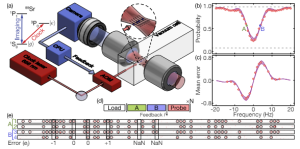
Abstract
Currently, the most accurate and stable clocks use optical interrogation of either a single ion or an ensemble of neutral atoms confined in an optical lattice. Here, we demonstrate a new optical clock system based on an array of individually trapped neutral atoms with single-atom readout, merging many of the benefits of ion and lattice clocks as well as creating a bridge to recently developed techniques in quantum simulation and computing with neutral atoms. We evaluate single-site resolved frequency shifts and short-term stability via self-comparison. Atom-by-atom feedback control enables direct experimental estimation of laser noise contributions. Results agree well with an ab initio Monte Carlo simulation that incorporates finite temperature, projective read-out, laser noise, and feedback dynamics. Our approach, based on a tweezer array, also suppresses interaction shifts while retaining a short dead time, all in a comparatively simple experimental setup suited for transportable operation. These results establish the foundations for a third optical clock platform and provide a novel starting point for entanglement-enhanced metrology, quantum clock networks, and applications in quantum computing and communication with individual neutral atoms that require optical clock state control.
Identification and control of electron-nuclear spin defects in diamond
Alexander Ungar, Paola Cappellaro, Alexandre Cooper, Won Kyu Calvin Sun
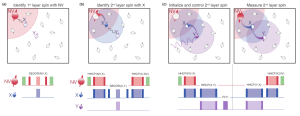
Abstract
Electronic spin defects in the environment of an optically-active spin can be used to increase the size and hence the performance of solid-state quantum registers, especially for applications in quantum metrology and quantum communication. Previous works on multi-qubit electronic-spin registers in the environment of a Nitrogen-Vacancy (NV) center in diamond have only included spins directly coupled to the NV. As this direct coupling is limited by the central spin coherence time, it significantly restricts the register’s maximum attainable size. To address this problem, we present a scalable approach to increase the size of electronic-spin registers. Our approach exploits a weakly-coupled probe spin together with double-resonance control sequences to mediate the transfer of spin polarization between the central NV spin and an environmental spin that is not directly coupled to it. We experimentally realize this approach to demonstrate the detection and coherent control of an unknown electronic spin outside the coherence limit of a central NV. Our work paves the way for engineering larger quantum spin registers with the potential to advance nanoscale sensing, enable correlated noise spectroscopy for error correction, and facilitate the realization of spin-chain quantum wires for quantum communication.
Alexandre Cooper, Won Kyu Calvin Sun, Jean-Christophe Jaskula, and Paola Cappellaro
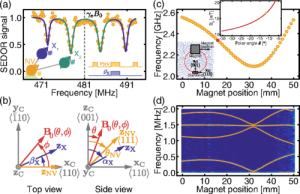
Abstract
We experimentally demonstrate an approach to scale up quantum devices by harnessing spin defects in the environment of a quantum probe. We follow this approach to identify, locate, and control two electron-nuclear spin defects in the environment of a single nitrogen-vacancy center in diamond. By performing spectroscopy at various orientations of the magnetic field, we extract the unknown parameters of the hyperfine and dipolar interaction tensors, which we use to locate the two spin defects and design control sequences to initialize, manipulate, and readout their quantum state. Finally, we create quantum coherence among the three electron spins, paving the way for the creation of genuine tripartite entanglement. This approach will be useful in assembling multispin quantum registers for applications in quantum sensing and quantum information processing.
Won Kyu Calvin Sun, Alexandre Cooper, Paola Cappellaro

Abstract
Entanglement, while being critical in many quantum applications, is difficult to characterize experimentally. While entanglement witnesses based on the fidelity to the target entangled state are efficient detectors of entanglement, they in general underestimate the amount of entanglement due to errors during state preparation and measurement. Therefore, to detect entanglement more robustly in the presence of such control errors, we introduce a ‘subspace’ witness that detects a broader class of entangled states with strictly larger violation than the conventional state-fidelity witness at the cost of additional measurements, while remaining more efficient with respect to state tomography. We experimentally demonstrate the advantages of the subspace witness by generating and detecting entanglement with a hybrid, two-qubit system composed of electronic spins in diamond. We further extend the notion of subspace witness to specific genuine multipartite entangled (GME) states such as GHZ, W, and Dicke states, and motivate the choice of the metric based on quantum information tasks such as entanglement-enhanced sensing. In addition, as the subspace witness identifies the many-body coherences of the target entangled state, it facilitates (beyond detection) lower-bound quantification of entanglement via generalized concurrences. We expect the straightforward and efficient implementation of subspace witnesses would be beneficial in detecting specific GME states in noisy, intermediate-scale quantum processors with a hundred qubits.
Quantum sensing with spin defects in diamond
Guoqing Wang, Yuan Zhu, Boning Li, Changhao Li, Lorenza Viola, Alexandre Cooper, Paola Cappellaro

Abstract
We introduce and experimentally demonstrate a quantum sensing protocol to sample and reconstruct the auto-correlation of a noise process using a single-qubit sensor under digital control modulation. This Walsh noise spectroscopy method exploits simple sequences of spin-flip pulses to generate a complete basis of digital filters that directly sample the power spectrum of the target noise in the sequency domain — from which the auto-correlation function in the time domain, as well as the power spectrum in the frequency domain, can be reconstructed using linear transformations. Our method, which can also be seen as an implementation of frame-based noise spectroscopy, solves the fundamental difficulty in sampling continuous functions with digital filters by introducing a transformation that relates the arithmetic and logical time domains. In comparison to standard, frequency-based dynamical-decoupling noise spectroscopy protocols, the accuracy of our method is only limited by the sampling and discretization in the time space and can be easily improved, even under limited evolution time due to decoherence and hardware limitations. Finally, we experimentally reconstruct the auto-correlation function of the effective magnetic field produced by the nuclear-spin bath on the electronic spin of a single nitrogen-vacancy center in diamond, discuss practical limitations of the method, and avenues for further improving the reconstruction accuracy.
Alexandre Cooper, Won Kyu Calvin Sun, Jean-Christophe Jaskula, and Paola Cappellaro
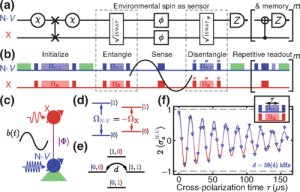
Abstract
The performance of solid-state quantum sensors based on electronic spin defects is often limited by the presence of environmental spin impurities that cause decoherence. A promising approach to improve these quantum sensors is to convert environment spins into useful resources for sensing, in particular, entangled states. However, the sensitivity enhancement that can be achieved from entangled states is limited by experimental constraints, such as control errors, decoherence, and time overheads. Here we experimentally demonstrate the efficient use of an unknown electronic spin defect in the proximity of a nitrogen-vacancy center in diamond to achieve both an entangled quantum sensor and a quantum memory for readout. We show that, whereas entanglement alone does not provide an enhancement in sensitivity, combining both entanglement and repetitive readout achieves an enhancement in performance over the use of a single-spin sensor, and more broadly we discuss regimes where sensitivity could be enhanced. Our results critically highlight the challenges in improving quantum sensors using entangled states of electronic spins, while providing an important benchmark in the quest for entanglement-assisted metrology.
A. Cooper, E. Magesan, H. N. Yum & P. Cappellaro
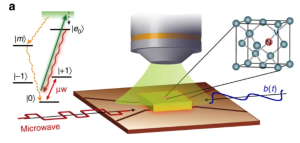
Abstract
Quantum probes can measure time-varying fields with high sensitivity and spatial resolution, enabling the study of biological, material and physical phenomena at the nanometre scale. In particular, nitrogen-vacancy centres in diamond have recently emerged as promising sensors of magnetic and electric fields. Although coherent control techniques have measured the amplitude of constant or oscillating fields, these techniques are not suitable for measuring time-varying fields with unknown dynamics. Here we introduce a coherent acquisition method to accurately reconstruct the temporal profile of time-varying fields using Walsh sequences. These decoupling sequences act as digital filters that efficiently extract spectral coefficients while suppressing decoherence, thus providing improved sensitivity over existing strategies. We experimentally reconstruct the magnetic field radiated by a physical model of a neuron using a single electronic spin in diamond and discuss practical applications. These results will be useful to implement time-resolved magnetic sensing with quantum probes at the nanometre scale.
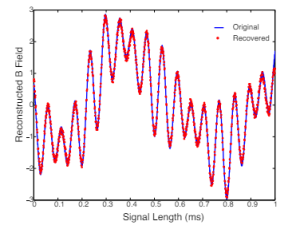
Abstract
We present methods that can provide an exponential savings in the resources required to perform dynamic parameter estimation using quantum systems. The key idea is to merge classical compressive sensing techniques with quantum control methods to efficiently estimate time-dependent parameters in the system Hamiltonian. We show that incoherent measurement bases and, more generally, suitable random measurement matrices can be created by performing simple control sequences on the quantum system. Since random measurement matrices satisfying the restricted isometry property can be used to reconstruct any sparse signal in an efficient manner, and many physical processes are approximately sparse in some basis, these methods can potentially be useful in a variety of applications such as quantum sensing and magnetometry. We illustrate the theoretical results throughout the presentation with various practically relevant numerical examples.
Phys. Rev. A 88, 062109 (2013) arXiv:1308.0313 (2013)Easwar Magesan, Alexandre Cooper, Honam Yum, Paola Cappellaro
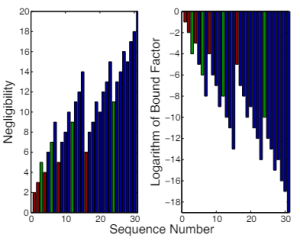
Abstract
Quantum systems have shown great promise for precision metrology thanks to advances in their control. This has allowed not only the sensitive estimation of external parameters but also the reconstruction of their temporal profile. In particular, quantum control techniques and orthogonal function theory have been applied to the reconstruction of the complete profiles of time-varying magnetic fields. Here, we provide a detailed theoretical analysis of the reconstruction method based on the Walsh functions, highlighting the relationship between the orthonormal Walsh basis, sensitivity of field reconstructions, data compression techniques, and dynamical decoupling theory. Specifically, we show how properties of the Walsh basis and a detailed sensitivity analysis of the reconstruction protocol provide a method to characterize the error between the reconstructed and true fields. In addition, we prove various results about the negligibility function on binary sequences which lead to data compression techniques in the Walsh basis and a more resource-efficient reconstruction protocol. The negligibility proves a fruitful concept to unify the information content of Walsh functions and their dynamical decoupling power, which makes the reconstruction method robust against noise.
Theses
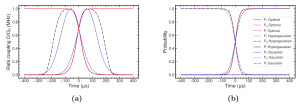
Abstract
In this thesis, we design a quantum optimal control protocol to mitigate the noise in Rydberg atom systems. First, we address the problem of simulating the dynamics of a single rubidium-87 atom excited to a Rydberg state in the presence of imperfections. Then, we design an optimal control protocol to mitigate the effect of physical imperfections and fluctuations in control parameters. This work will be useful for applications in quantum information processing and quantum simulation.
UwSpace (2021)Parth Padia
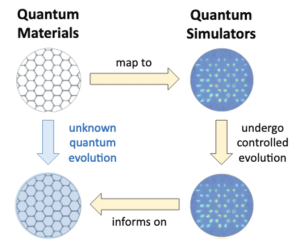
Abstract
Quantum materials offer tremendous potential for advancing electronic devices beyond traditional semiconductor-based technologies. Understanding the dynamics of these materials requires the use of quantum simulators. Quantum simulators are controlled many-body quantum systems that mimic the dynamics of a targeted quantum system. The three key features of a quantum simulator are controllability, scalability, and interactability. Controllability denotes the ability to address an individual quantum system. Scalability refers to extending this control to multiple quantum systems while maintaining their interconnectivity with a polynomial increase in resources. Interactability, on the other hand, denotes the capability to establish strong tunable interactions between a pair of quantum systems. This thesis addresses the challenges of attaining controllability and scalability within the current Noisy Intermediate-Scale Quantum (NISQ) era, characterized by limited and errorprone qubits, for a neutral atom-based quantum simulator. The constraints in qubit interconnectivity necessitate the use of additional swap gates for operations between non-adjacent qubits, increasing errors. To reduce these gate-based errors, we improve qubit interconnectivity by displacing atoms during simulation, thus enhancing our simulator’s scalability. We compare approaches with and without atom displacement analytically and numerically, employing metrics like circuit fidelity and quantum volume. Our analysis introduces a novel metric, denoted as ηprotocol, for comparing compilation protocols incorporating atom displacement. Additionally, we establish an inequality involving the η platform metric to compare operational protocols with and without atom displacement. We conclude from our quantum volume study that protocols assisted by atom displacement can achieve a quantum volume of 27, a significant improvement over the 26 attainable without atom displacement with the state-of-the-art two-qubit gate infidelity of 5e-3 and atom displacement infidelity of 1.8e-4. Implementing a dedicated closed-loop control and acquisition system showcases our simulator’s controllability. The system integrates machine learning techniques to automate experiment composition, execution, and analysis, resulting in faster and automated control parameter optimization. A practical demonstration of this optimization is conducted through imaging an atomic cloud composed of Rb-87 atoms, the first step in undertaking quantum simulations with neutral atom arrays. The research presented in this thesis contributes to the understanding and advancement of quantum simulators, paving the way for developing new devices with quantum materials.
Patents
US11,631,024 B2 · Issued Apr 18, 2023
An apparatus useful for creating and measuring states of an entangled system, comprising a pair of interacting multi-level systems, each of systems comprising a state |g>; a state |r>, and state |r*>. One or more first electromagnetic fields excite a first transition between the ground state |g> and the state |r> to create an entangled system. One or more second electromagnetic fields are tuned between the state |r> and the intermediate state |r*> so that any population of the systems in |r*> are dark to a subsequent detection of a population in the systems in |g>, providing a means to distinguish the entangled system in the state |g> and the entangled system in the state |r>. In one or more examples, the systems comprise neutral Rydberg atoms.
US 11,293,851 B2 · Issued Apr 5, 2022
An apparatus for individually trapping atoms, individually imaging the atoms, and individually cooling the atoms to prevent loss of the atoms from the trap caused by the imaging. The apparatus can be implemented in various quantum computing, sensing, and metrology applications (e.g., in an atomic clock).
US 10,809,177 B2 · Issued Oct 20, 2020US
An apparatus for individually trapping atoms, individually imaging the atoms, and individually cooling the atoms to prevent loss of the atoms from the trap caused by the imaging. The apparatus can be implemented in various quantum computing, sensing, and metrology applications (e.g., in an atomic clock).
US 9664767B2 · Issued May 30, 2017
A system for performing Walsh reconstruction of time dependent fields with a quantum probe that includes a diamond structure that includes nitrogen-vacancy (NV) centers for sensing magnetic and electric fields. An arbitrary waveform generator and microwave waveguides manipulate the quantum spins in the diamond structure using a plurality of coherent control sequences to measure the arbitrary profile of time-varying magnetic fields. A laser that optically addresses the quantum spins in the diamond structure for initialization and readout.
US 2024/0184845 Al · Issued Jun 6, 2024
A computer-implemented method of solving a reconfguration problem, the method comprising: solving an all-pairs shortest path (APSP) problem, including computing a distance between each token source location and each token
target location; solving an assignment problem on the computed distances, said solving the assignment problem yielding a path system having a set of shortest paths; performing a cycle breaking function on the path system, the cyclebreaking function breaking all cycles in the path system; and ordering order the cycle free path system.
US 2024/0186029 Al · Issued Jun 6, 2024
The specification describes a method of reconfguring particles in a grid of particle traps from an initial configuration to a target confguration, the grid of particle traps having target particle traps and surplus particle traps, the particles being movable along rows of the grid, or along columns of the grid, the rows being transversal to the columns.